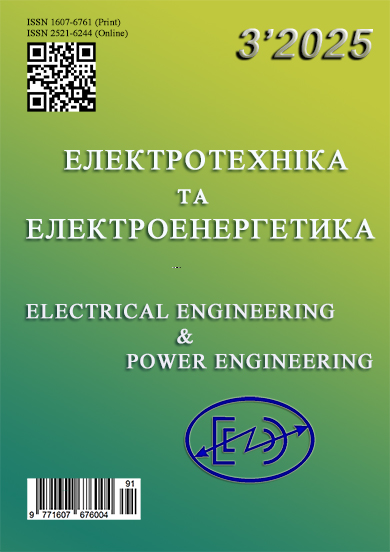Way to implementation in relay protection of the algorithm for searching for pre-fault operating conditions by using a neural network with backpropagation spot training
DOI:
https://doi.org/10.15588/1607-6761-2025-3-6Keywords:
limit and pre-emergency modes, relay protection, graph neural networks, reinforcement learning, power systems, electric power engineeringAbstract
Purpose. The purpose of this paper is to develop and validate a novel method for searching critical and pre-fault operating conditions in power systems for relay protection setting calculation. The proposed approach is based on the integration of graph neural networks with deep reinforcement learning (GNN-DRL) and aims to significantly reduce computational time while maintaining high accuracy and ensuring protection selectivity.
Findings. It is demonstrated that the proposed GNN-DRL method achieves a 10–1000 times reduction in computational overhead compared to traditional brute-force approaches. The prediction accuracy exceeds 90%, while e-accuracy surpasses 98%. The method proves to be highly effective both in determining maximum fault currents for instantaneous overcurrent protection and in large-scale scenarios on extended test systems.
Originality. For the first time, the integration of graph neural networks with the Dueling Double Deep Q Network algorithm is proposed to solve the problem of searching for critical and pre-fault operating conditions in relay protection. A unique two-stage training framework, GLFE, is developed, combining elements of supervised and unsupervised learning. This enables high prediction accuracy while requiring significantly fewer training samples.
Practical value. The results of this study can be applied in the design of intelligent relay protection and automation systems for electric power networks. The proposed method is capable of adapting to fast-changing conditions in power systems with high penetration of renewable energy. Furthermore, the architecture can be extended to other optimization and control problems in complex energy environments.
References
Mishra, A., & Shukla, S. (2025). A comprehensive review on deep learning techniques in power system protection: Trends, challenges, applications and fu-ture directions. Electric Power Systems Research, 229, 110163. https://doi.org/10.1016/j.epsr.2025.110163
Fang, J., & Zhang, X. (2019). Research on power sys-tem relay protection method based on machine learning algorithm. E3S Web of Conferences, 118, 01038. https://doi.org/10.1051/e3sconf/201911801038
López-Cardona, A., Bernardez, G., Barlet-Rose, P., & Cabellos-Aparicio, A. (2025). Proximal policy opti-mization with graph neural networks for optimal power flow. In Proceedings of the 14th International Conference on Data Science (DATA 2025) (pp. 45–56). https://doi.org/10.5220/0013462700003763
Kulikov, A., Kryukov, A., Malygin, I., Bystrov, D., & Shandarova, E. (2022). Relay protection and auto-mation algorithms of electrical networks based on simulation and machine learning methods. Energies, 15(18), 6525. https://doi.org/10.3390/en15186525
Zhou, L., Li, J., & Wang, S. (2025). Optimal power flow for high spatial and temporal resolution with GNN-DRL in systems with renewables. Energies, 18(7), 1809. https://doi.org/10.3390/en18071809
Murugesan, A., Rao, A., & Zhang, Y. (2025). Ma-chine learning-driven intelligent voltage control in RES-integrated systems. Electric Power Systems Re-search, 233, 110269. https://doi.org/10.1016/j.epsr.2025.110269
Shobole, A. A., Hassan, K., & Ahmed, R. (2024). Multi-agent system based adaptive numerical relay design. International Journal of Electrical Power & Energy Systems, 155, 109540. https://doi.org/10.1016/j.ijepes.2024.109540
Sarajcev, P., Dujic, D., & Baric, A. (2024). Machine learning classifier for supporting generator’s un-derimpedance (21G) and out-of-step (78) protection functions. Energies, 17(8), 1820. https://doi.org/10.3390/en17081820
Porawagamage, G., Dharmapala, K., Chaves, J. S., Villegas, D., & Rajapakse, A. (2024). A review of machine learning applications in power system pro-tection and emergency control: Opportunities, chal-lenges, and future directions. Frontiers in Smart Grids, 1, 1371153. https://doi.org/10.3389/frsgr.2024.1371153
Chen, Y., Zhang, L., & Li, M. (2024). Artificial Intelli-gence/Machine Learning Technology in Power Sys-tem Applications (PNNL Technical Report PNNL-35735). https://doi.org/10.2172/2334567
Ghamizi, S., Bojchevski, A., Ma, A., & Cao, J. (2024). SafePowerGraph: Safety-aware evaluation of graph neural networks for transmission power grids. arXiv preprint, arXiv:2407.12421.
Hansen, J. B., Anfinsen, S. N., & Bianchi, F. M. (2021). Power flow balancing with decentralized graph neural networks. arXiv preprint, arXiv:2111.02169.
Maiti, S., & Dey, S. (2024). Smart grid security: A verified deep reinforcement learning framework to counter cyber-physical attacks. arXiv preprint, arXiv:2409.15757.
Pei, Y., Wang, Q., & Liu, H. (2023). An emergency control strategy for undervoltage load shedding based on a graph deep reinforcement learning meth-od named GraphSAGE-D3QN. IET Generation, Transmission & Distribution, 17(5), 789–799. https://doi.org/10.1049/gtd2.12795
Yuan, Y., Li, T., & Wang, Y. (2020). Deep reinforce-ment learning for power system transient stability control. IEEE Transactions on Power Systems, 35(4), 3130–3140. https://doi.org/10.1109/TPWRS.2019.2963725
Liu, Z., Zhao, J., & Zhang, Y. (2022). Graph convolu-tional networks for fault location in power distribu-tion systems. IEEE Transactions on Smart Grid, 13(1), 789–799. https://doi.org/10.1109/TSG.2021.3098361
Karimi, H., Li, Z., & Hong, S. H. (2021). A hybrid machine learning and optimization approach for adaptive protection in microgrids. International Journal of Electrical Power & Energy Systems, 125, 106458. https://doi.org/10.1016/j.ijepes.2020.106458
Wang, J., Sun, Y., & Chen, C. (2021). Reinforcement learning-based optimal control for power system fre-quency regulation. IEEE Access, 9, 14567–14577. https://doi.org/10.1109/ACCESS.2021.3053456
Zhang, X., Zhou, M., & Li, H. (2023). Fault diagnosis in smart grids using graph neural networks. Applied Energy, 341, 121037. https://doi.org/10.1016/j.apenergy.2023.121037
Xu, K., He, Y., & Tang, F. (2022). Deep Q-learning for adaptive overcurrent relay coordination in distribu-tion systems. Electric Power Components and Sys-tems, 50(15), 1689–1701. https://doi.org/10.1080/15325008.2022.2106765
Downloads
Published
How to Cite
Issue
Section
License
Copyright (c) 2025 V.M. Tsiupa, D.O. Danylchenko

This work is licensed under a Creative Commons Attribution-ShareAlike 4.0 International License.
Creative Commons Licensing Notifications in the Copyright Notices
Authors who publish with this journal agree to the following terms:
Authors retain copyright and grant the journal right of first publication with the work simultaneously licensed under aCreative Commons Attribution License that allows others to share the work with an acknowledgement of the work's authorship and initial publication in this journal.
Authors are able to enter into separate, additional contractual arrangements for the non-exclusive distribution of the journal's published version of the work (e.g., post it to an institutional repository or publish it in a book), with an acknowledgement of its initial publication in this journal.
Authors are permitted and encouraged to post their work online (e.g., in institutional repositories or on their website) prior to and during the submission process, as it can lead to productive exchanges, as well as earlier and greater citation of published work.

